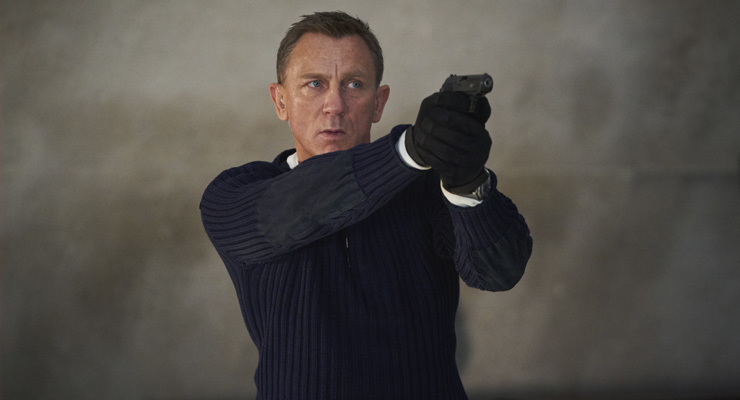
Daniel Craig in a scene from "No Time to Die," an EON Productions and Metro-Goldwyn-Mayer Studios film. Credit: Nicola Dove. © 2021 DANJAQ, LLC AND MGM. ALL RIGHTS RESERVED.
The cowboy stares into the lens and does nothing for several seconds. Then he pulls out a gun and fires all six shots in his barrel. Straight into the camera. Those iconic 14 seconds from Edwin S. Porter's “The Great Train Robbery” are instantly recognizable by moviegoers, even those who don't know where the silent film footage came from.
Movies have gotten a lot more sophisticated since 1903, but filmmakers have kept coming back to the image of a man and a firearm, across several genres, often to romanticize dog-eared notions of virility and prowess, but in later decades with the intention of deconstructing these figures.
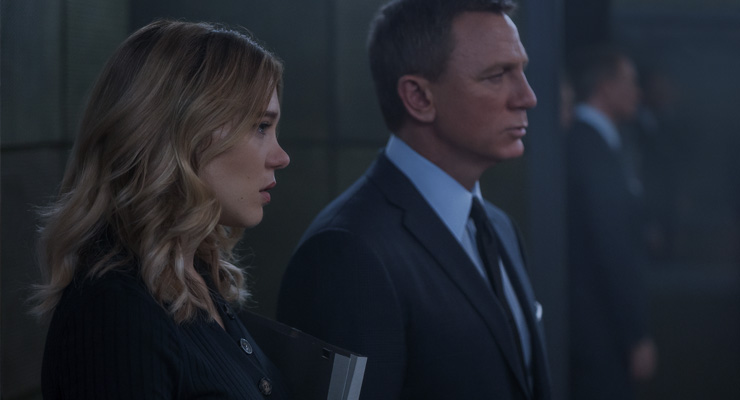
Léa Seydoux and Daniel Craig in a scene from "No Time to Die," an EON Productions and Metro-Goldwyn-Mayer Studios film. Credit: Nicola Dove. © 2021 DANJAQ, LLC AND MGM. ALL RIGHTS RESERVED.
One of those men, a figment of English author Sir Ian Fleming's imagination, defined masculinity for generations, first on the page, then with more widespread visibility on the big screen. The first James Bond films, starring a suave, cool-as-ice Sean Connery, were released around the same time Westerns were making the transition from movies to television. And yet, as much as the old-fashioned oater is written off as a “dying” genre, they still wind up being made and released.
The spy film and the Western. Two staples of Dad cinema. Never really out for the count, not even amid the current landscape where costumed do-gooders take up most of the screen real estate at your local multiplex and still suck up all the oxygen in the room. Two such films are available for South Floridians' consumption as of this weekend. One is the COVID-delayed release of the latest Bond adventure. The other is an independently made Western, one that gives a consummate character actor a chance to shine in a lead role. My mission, should I choose to accept it, is to take a closer look at these new releases.
“No Time to Die”: How long has it been since the fifth and final James Bond outing headlined by Daniel Craig was supposed to come out in theaters? It had an original release date of November 2019 when “Slumdog Millionaire” director Danny Boyle was attached. Once he was out of the picture, and “True Detective” Season 1 helmer Cary Joji Fukunaga was brought in to direct, Metro-Goldwyn-Mayer eyed a spring 2020 release. Then COVID happened. Release dates kept being pushed forward like the boarding gates at the end of “Airplane!”
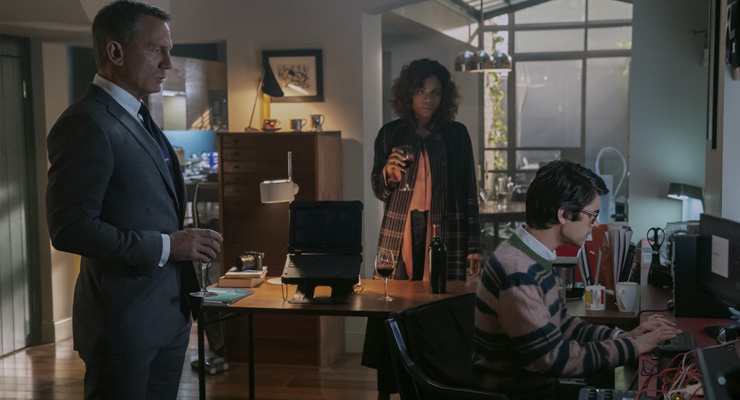
Daniel Craig, Naomie Harris and Ben Whishaw in a scene from "No Time to Die," an EON Productions and Metro-Goldwyn-Mayer Studios film. Credit: Nicola Dove. © 2021 DANJAQ, LLC AND MGM. ALL RIGHTS RESERVED.
To put it in even more stark terms, Connery, still widely considered the gold standard in the role, would have been alive if the film had been released as planned. The Oscar-winning Scot died at the end of October 2020. Nearly an entire year has gone by since then.
So, here we are, roughly a year and a half later. Was it worth the wait? And was the decision to stick with a theaters-only commercial release justified? The short answer to these questions is yes, but there's a lot to untangle in this epic-sized slab of international intrigue and existential angst that, at 163 minutes, is officially the longest Bond to date.
Fortunately, this production has in Fukunaga a filmmaker with a disciplined approach to narrative and a no-frills approach to action. His grasp of the myriad elements coming together here is enough to merit the plus-sized running time. At least until it isn't.
“No Time to Die” begins with a prologue involving Madeleine, the psychologist introduced as a love interest in “Spectre” (aka Bond/Craig #4), back when the character was a girl. A traumatic set of events with lasting repercussions reveals a special kinship between the French woman, played as an adult by Léa Seydoux, and Bond. A good thing, too, since they end up together at the end of “Spectre.”
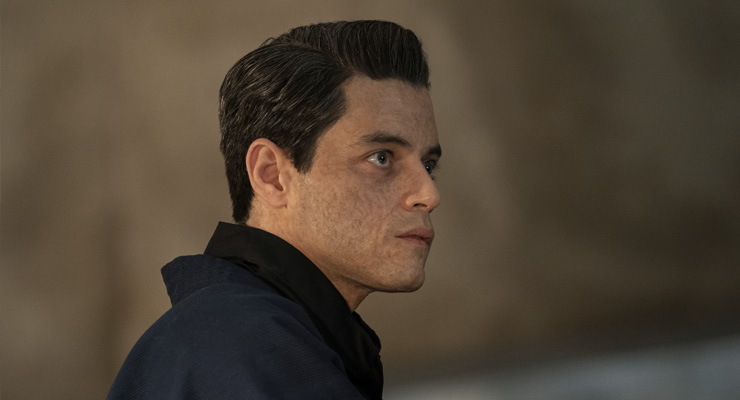
Rami Malek in a scene from "No Time to Die," an EON Productions and Metro-Goldwyn-Mayer Studios film. Credit: Nicola Dove. © 2021 DANJAQ, LLC AND MGM. ALL RIGHTS RESERVED.
Alas, Craig's Bond has deep-seated trust issues, and as “No Time” continues its prolonged intro we discover dark forces are conspiring to trigger now former Agent Damaged Goods as he strives to bury the past and embark on a new life with Madeleine.
Sudden violence in the south of Italy leads to an accusation of betrayal, and the attractive couple part ways. The film jumps forward five years, which is one year less than we've had to wait since “Spectre,” with a slightly unkempt Bond, whiling away the days in Jamaica, being roped into one last mission, for old time's sake, by CIA operative Felix Leiter (Jeffrey Wright). Their target is Valdo Obruchev (David Dencik), a kidnapped MI6 scientist who has developed a bioweapon aimed at reducing collateral damage but that could lead to global annihilation if it falls in the wrong hands.
Bond accompanies Leiter and his colleague, Logan Ash (Billy Magnussen) to Santiago de Cuba, where he is paired up with Paloma (an all-too-brief turn from Craig's “Knives Out” co-star Ana de Armas) to help retrieve Obruchev. There he crosses paths with Nomi (Lashana Lynch), his replacement as 007 after he rode off into the sunset with Madeleine at the end of “Spectre.”
The already dense plot thickens even further, more familiar faces appear, and Bond is sent on a rocky path that inevitably leads him to shadowy anarchist Lyutsifer Safin (Rami Malek, channeling Peter Lorre). It's commendable how Fukunaga, working from a screenplay credited to him, longtime Bond scribes Neal Purvis and Robert Wade, and “Fleabag” star and creator Phoebe Waller-Bridge, is able to balance all of these story elements. Kudos to editors Tom Cross (“Whiplash”) and Elliot Graham (“Captain Marvel”) for keeping the momentum going without making it feel rushed.
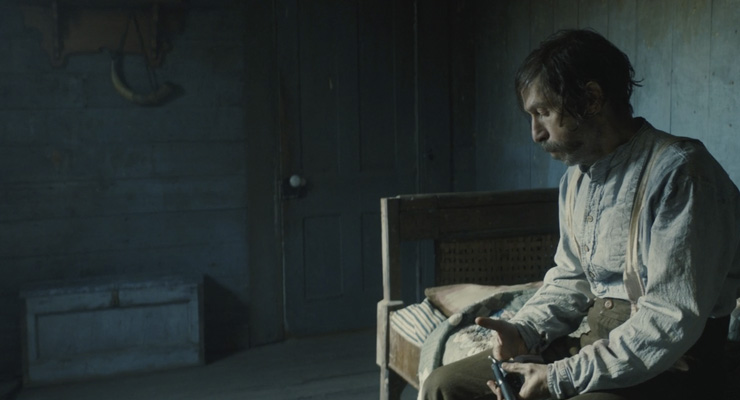
Tim Blake Nelson in a scene from "Old Henry." Courtesy: Shout! Studios.
But as “No Time to Die” enters its third hour, that steady pace slackens, and what started out as an agreeable balance of adventure and character introspection takes a distracting detour into Bond's personal life. On paper, it sounds like the antidote to the increasingly soulless last couple of Bond pictures. (I'm aware “Skyfall” is revered among purists, and it does feature one of the franchise's better villains in Javier Bardem, but director Sam Mendes' Bond stint mostly put me to sleep.) Up on the screen, however, Craig's swan song starts resembling a soap opera in all kinds of reductive ways, all the more disappointing considering Fukunaga helmed a tough, unsentimental and deeply romantic adaptation of “Jane Eyre,” starring Mia Wasikowska and Michael Fassbender, released in 2011. It's clear his heart is in the right place, but for all the efforts in front of and behind the camera, Bond's relationship with Madeleine never stops feeling like a plot device. And it still comes across as the sappiest Bond movie ever made.
So what keeps this bulky ship afloat? A sturdy star turn from Craig, for one. He might have sleepwalked through most of “Spectre,” but he doesn't phone it in this time. It doesn't hurt that cinematographer Linus Sandgren (“La La Land”) makes the actor's steely baby blues pop. More importantly, there's a palpable awareness that many aspects of this aging franchise have long passed their expiration date. The filmmakers know it's time to clean house and start fresh, and while news that the series will, indeed, go on after Craig's departure might not be what this exhausted fan wanted to hear, there are signs throughout “No Time to Die” that interesting changes are likely on the horizon. It's an imperfect finale to an imperfect run, but I daresay it paves the way for a new incarnation with potential as vast as Her Majesty's reign.
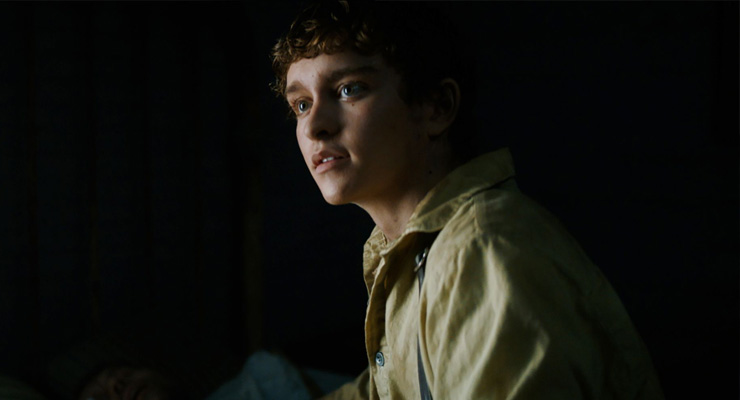
Gavin Lewis in a scene from "Old Henry." Courtesy: Shout! Studios.
“Old Henry”: Craig is not the only star out there playing a gunman grappling with the man he used to be. In this modestly scaled, beautifully rendered Western, Tim Blake Nelson saddles into a starring role that might appear minor at first glance, but like the rest of the movie, continues to grow in stature as it unfolds.
The frequent Coen brothers collaborator plays the titular character, a widowed farmer in the Oklahoma Territory circa 1906 (three years after “The Great Train Robbery” debuted) whose quiet routine, alongside his teenage son Wyatt (“Little Fires Everywhere's” Gavin Lewis), is disrupted when he finds an injured man carrying a satchel full of money.
Things are home are already tense. Wyatt is resentful his father won't teach him how to shoot or let him do anything that would entail leaving the farm. When Henry brings in Curry (Scott Haze), suffering from a chest wound, the household turns even more of a pressure cooker.
Hot on Curry's trail are three men with what appear to be badges but curiously lacking the lawful behavior associated with them. They're led by Ketchum (a weathered Stephen Dorff), whose drive in retrieving the loot in Curry's possession is only equaled by his cold-blooded penchant for cruelty.
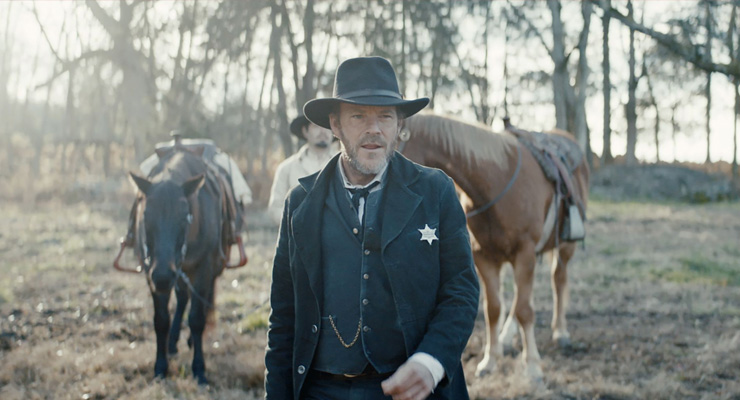
Stephen Dorff in a scene from "Old Henry." Courtesy: Shout! Studios.
Writer-director Potsy Ponciroli plays heartfelt homage to the genre's iconic moments, including the requisite doorway shot from “The Searchers.” But despite a gentleness that occasionally recalls John Ford, “Old Henry” hews closer to directors like Sam Peckinpah, Fred Zinnemann and Samuel Fuller. Ponciroli is a tad too in thrall of the tropes that define the genre, and some of his dialogue betrays a fanboy's devotion at the expense of authenticity. Less would have been more, especially in the case of Curry, a character saddled with more exposition than any actor could handle, though Haze, shrewdly cast as a stranger whose allegiance remains unclear, gives it his all.
Ponciroli also struggles with the father-son conflict. The characters' head butting would have been a lot more effective if fewer words were exchanged. One certainly wishes Wyatt were less of a whiner, though some of his lashing out carries a lacerating sting. Nevertheless, the strain is apparent.
But despite these issues, it's clear the filmmaker is a natural born storyteller, and in cinematographer John Matysiak, he has found an ideal collaborator. Ponciroli's leisurely cadences are matched by Matysiak's sun-baked compositions. This is a film that makes full use of long shots, and the immaculate framing here belies its low budget.
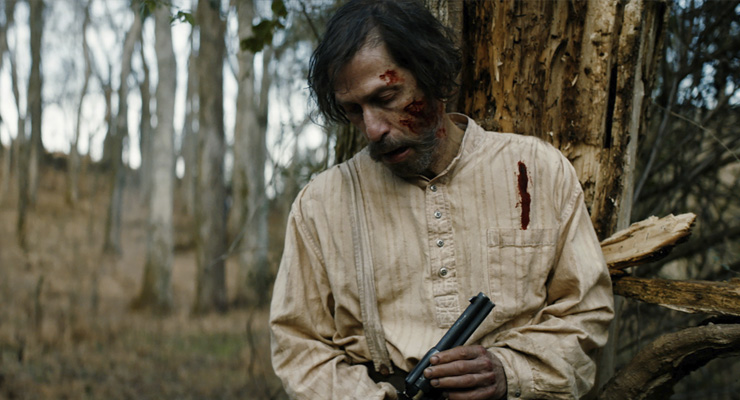
Tim Blake Nelson in a scene from "Old Henry." Courtesy: Shout! Studios.
It's a testament to the strength of the material that it's taken me this long to get to Nelson. His performance reminded me of Viggo Mortensen's in “A History of Violence” in the way a placid demeanor can be a smoke screen for hidden talents. The way he awakens the gunslinger within, leading to an expertly staged and edited shootout, showcases just how satisfying old-school oaters can be when handled with care. Such is the case with this bloody, compassionate tale that dares to find hope in the most dire of situations. It also shows pigs will eat anything. Any. Thing.
“No Time to Die” is now showing in wide release across South Florida, including IMAX engagements at Regal South Beach, AMC Aventura, AMC Sunset Place and the AutoNation IMAX at the Museum of Discovery & Science in Fort Lauderdale. “Old Henry” is available for digital rental on iTunes, Spectrum On Demand and other platforms. Palm Beach County residents can see it on the big screen, where it belongs, at Cinépolis Luxury Cinemas in Jupiter. It's set to be released on DVD and Blu-ray Nov. 9. Both films are susceptible to spoilers, so be careful on social media.




